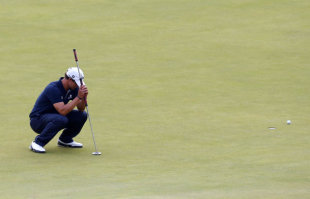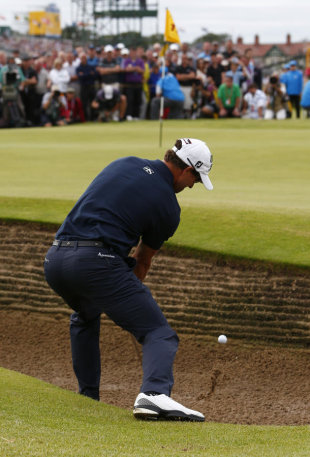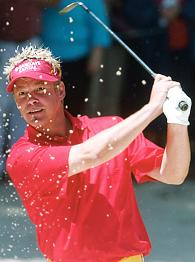 Adam Scott, unable to believe that he has just lost The Open
Adam Scott, unable to believe that he has just lost The Open
Adam Scott has always wanted to tread in the footsteps of his boyhood hero, Greg Norman. But instead of joining his fellow Aussie in winning the Open Championship, he has instead copied his famously unfortunate habit of losing a Major championship in outrageous circumstances.
There were many cruel ironies about what happened to Scott on Sunday afternoon, as he blew a four-shot lead with four holes to go at Royal Lytham & St Annes.
There's the irony that by playing it safe on the final four holes, he opened himself up to mistakes that he would never have made had he gone for his shots.
There's a worse irony in that his demise happened to coincide with an hour and a half of inspired golf by his good friend Ernie Els, playing the best back nine of the week at Lytham in the toughest conditions of the week.
And there's the irony that Scott shares his surname with the Antarctic adventurer whose name is already a byword for failure thanks to a doomed expedition that is one the great romantic tragedies of the age of exploration.
But the cruellest irony by far is that Scott's implosion will make him, like Norman, far more famous for his failure than for his victories.
This truly was a collapse for the ages, instantly becoming one of the most astonishing stories in golf, and it's a story that was written in the space of half an hour.
It all looked so promising: Scott showed a few early nerves as he made three bogeys in his first six holes at Lytham, but two of them were sheer bad bounces and the third — a thinned bunker shot at the 6th — hardly a terrible golfing crime.
Thereafter he remained solid as a rock, and when a huge drive up the 14th was followed with a magnificent wedge to eight feet to set up a birdie, it all looked over.
That, however, was the beginning of the end for Scott. A slightly crooked shot with his conservative tee shot on the next hole left him a long way back, and his long iron found an awkward spot in a greenside bunker. The resulting escape to 10 feet was not close enough: a bogey followed but at nine under par he was still three clear.
 Adam Scott's horrible stance in the bunker on the 15th hole
Adam Scott's horrible stance in the bunker on the 15th hole
The 16th was worse: he played safe by hitting an iron down the fairway, but an awful wedge miles past the pin resulted in a three putt. He caught an awful lie in thick rough near the green on 17, and his par putt missed moments after Ernie Els's birdie putt on the 18th went in.
To the last then, and Scott drove a 3-wood into sand when a driver would have taken the traps out of range, and an iron would have ensured they were unreachable.
Even still, after splashing out sideways he hit a great shot to give himself a chance of par from 12ft — but ironically, his touch with his long putter deserted him just when he needed it most.
Scott's groan almost as soon as he hit the putt was clearly audible despite the thousands of fans packed around the 18th green — and the putt never went close to going in.
And, even as the ball was still running past the hole, Scott joined an elite band of men who have thrown away Majors in exquisitely horrible circumstances up the stretch.
We're not talking about the likes of Rory McIlroy at the Masters in 2011, when he imploded in the final round. Simply having a bad day at the office is just something that happens from time to time to guys leading Majors on the final day. The same happened toDustin Johnson at Pebble Beach the year before, and we'd even put Greg Norman's loss to Nick Faldo at the 1996 Masters in that same bracket.
What is much less common are the guys who appear to have beaten the nerves and taken the tournament in hand, but still somehow contrived not to win.
There was Arnold Palmer at the 1966 US Open, who led by seven shots with nine holes left, and by five shots with four holes left. Palmer then bogeyed three holes in a row as Billy Casper made two birdies; Casper went on to win the play-off, and Palmer never won another Major.
Four years later at The Open at St Andrews, Doug Sanders outplayed the legendary Jack Nicklaus and earned himself a two-foot putt to win the Claret Jug. He missed.
That was the shortest putt ever missed to win a Major until Scott Hoch missed an 18-incher for the Masters in a play-off against Nick Faldo in 1989, but even that was trumped earlier this year when Korea's Kim In-Kyung missed a 12-inch tap in to win the Kraft-Nabisco Championship.
Missing one shot is one thing, though: a late blow-up in sight of the finishing line is of a higher order, as Thomas Bjorn showed with his three shots to escape a bunker on the 70th hole of the 2003 Open Championship while leading by two.
Even that is not as heartbreaking as Scott's disaster, however. There's only one that really compares, and that's the mother of all golfing blow-ups at the 1999 Open.
Jean van de Velde played the final hole at Carnoustie in a stunningly inept manner as he blew The Open with a lunatic high-risk strategy on the final hole, which is one of the hardest par-4s in championship golf, when 4-iron onto the fairway and two wedges would have secured him the title.
But Van de Velde became a global icon as the picture of him minus his socks standing in the Barry Burn was beamed around the world — and so it will be with Scott.
One of the photographers on the course will have snapped the perfect picture — perhaps Scott's shocked face as his three-footer for par horseshoed out at the 16th — which will freeze Scott's pain in time for all golfing eternity.
The big question is this, though: was Scott's capitulation at Lytham worse than Jean van de Velde's at Carnoustie? The sad truth is that it probably was. Van de Velde made one bad swing — off the tee — and compounded the error, and the fact that he was a journeyman who had never really been expected to contend in the first place somehow made it easier to witness. It was a bit like seeing a lottery winner accidentally drop their ticket into a shredder: harsh, but sort of funny. Easy come, easy go.
By contrast, watching Scott fail was like watching a mountaineer come within one final step of reaching the summit of Everest, only to slip all the way back down the mountain.
One thing is for certain, though: should he ever get another chance to make it to the top, he'll know exactly how to make that final move.
If he does make it, it'll be all the sweeter for the failure that went before it. And if not? Well, he's already guaranteed a prime spot in the golfing history books regardless. Right alongside his hero Greg Norman.


